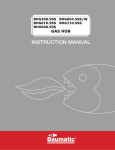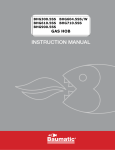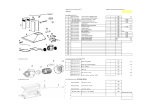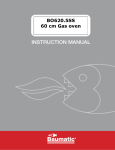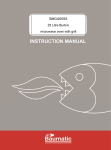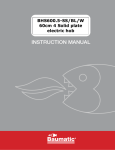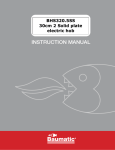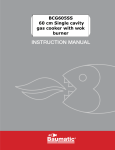Download Baumatic BHG900.6SS Instruction manual
Transcript
BHG900.6SS 90 cm 5 Burner Gas Hob INSTRUCTION MANUAL INSTRUCTIONS AND ADVICE FOR THE USE, INSTALLATION AND MAINTENANCE OF MIXED AND GAS FUELLED BUILT-IN HOBS Dear Customer, Thank you for having purchased one of our products. We are certain that this new, modern, functional and practical appliance, built with the very highest quality materials, will meet your requirements in the best possible way. This appliance is easy to use. It is, however, important to thoroughly read the instructions in this handbook in order to obtain the best results. These instructions are only valid for the countries of destination, the identification symbols of which are indicated on the cover of the instruction manual and on the appliance itself. The manufacturer shall not be held responsible for any damages to persons or property caused by incorrect installation or use of the appliance. MODEL: BHG900.6SS The Manufacturer shall not be held responsible for any inaccuracies in this handbook due to printing or transcription errors; the designs in the figures are purely indicative. The Manufacturer also reserves the right to make any modifications to the products as may be considered necessary or useful, also in the interests of the user, without jeopardizing the main functional and safety features of the products themselves.This gas hob was designed to be used exclusively as a cooking appliance: any other use (such as heating rooms) is to be considered improper and dangerous. COD. 04057LC - 05.09.2013 DESCRIPTION OF THE GAS HOBS MOD: MOD: MOD: BHG900.6SS MOD: 1 Ultra rapid burner 2 Rapid burner 3 Semirapid gas burner 4 Auxiliary gas burner 5 Pan stand support right 6 Pan stand support Ultra rapid burner 7 Pan stand support left 8 Burner n° 1 control knob 9 Burner n° 2 control knob 10 Burner n° 3 control knob 11 Burner n° 4 control knob 12 Wok pan support (Only ultra rapid gas burner) 13 Semirapid gas burner reduced 14 Burner n° 13 control knob of of of of 3100 W 2800 W 1750 W 1000 W of 1400 W Attention: This appliance has been manufactured for domestic use only and it's use by private persons. 2 USE 1) BURNERS Burners A diagram is printed above each knob on the front panel. This diagram indicates to which burner the knob in question corresponds. After having opened the gas mains or gas bottle tap, light the burners as described below: - Manual ignition Push and turn the knob corresponding to the required burner in an anticlockwise direction until it reaches the full on position (large flame fig. 1), then place a lighted match near the burner. - Automatic electrical ignition Push and turn the knob corresponding to the required burner in an anticlockwise direction until it reaches the full on position (large flame fig. 1), then depress the knob. - Lighting burners equipped with flame failure device The knobs of burners equipped with flame failure device must be turned in an anticlockwise direction until they reach the full on position (large flame fig. 1) and come to a stop. Now depress the knob in question and repeat the previously indicated operations. Keep the knob depressed for about 10 seconds once the burner has ignited. Ultra rapid Rapid Semirapid reduced Semirapid Auxiliary Power ratings 3100 2800 1400 1750 1000 Pan Ø in cm 24 ÷ 26 20 ÷ 22 16 ÷ 18 16 ÷ 18 10 ÷ 14 WARNINGS: - Burners with flame failure device may only be ignited when the relative knob has been set to the Full on position (large flame fig. 1). - Matches can be used to ignite the burners in a blackout. - Never leave the appliance unattended when the burners are being used. Make sure there are no children in the near vicinity. Particularly make sure that the pan handles are correctly positioned and keep a check on foods requiring oil and grease to cook since these products can easily catch fire. - Never use aerosols near the appliance when it is operating. - If the built-in gas hob has a lid, any spilt food should be immediately removed from this before it is opened. I f the appliance has a glass lid, this could shatter when the hob becomes hot. Always switch off all the burners before closing the lid. - Do not use the hob as a work surface. - Do not place pans with an unstable or deformed bottom on the burner, as these may tip or spill their contents, causing accidents. The appliance must not be used by people (including children) with impaired mental or physical capacities, or without experience of using electrical devices, unless supervised or instructed by an expert adult responsible for their care and safety. Children should not be allowed to play with the equipment. - Containers wider than the unit are not recommended. HOW TO USE THE BURNERS Bear in mind the following indications in order to achieve maximum efficiency with the least possible gas consumption: - Use adequate pans for each burner (consult the following table and fig. 2). - When the pan comes to the boil, set the knob to the reduced rate position (small flame fig. 1). - Always place a lid on the pans. - Use only pan with a flat bottom. FIG. 1 FIG. 2 3 USE WARNINGS AND ADVICE FOR THE USER: Use of a gas cooking appliance produces heat and moisture in the room in which it is installed. The room must therefore be well ventilated by keeping the natural air vents clear (fig. 3) and by activating the mechanical aeration device (extraction hood or electric fan fig. 4 and fig. 5).Intensive and lengthy use of the appliance may require additional ventilation. This can be achieved by opening a window or by increasing the power of the mechanical exhausting system if installed. - Do not attempt to change the technical characteristics of the product because it can be dangerous. - If you should not to use this appliance any more (or replace an old model), before disposing of it, make it inoperative in conformity with current law on the protection of health and the prevention of environmental pollution by making its dangerous parts harmless, especially for children who might play on an abandoned appliance. - Do not touch the appliance with wet or damp hands or feet. - Do not use the appliance barefoot. - The manufacturer will not be liable for any damage resulting from improper, incorrect or unreasonable use. - During, and immediately after operation, some parts of the hob are very hot: avoid touching them. - After using the hob, make sure that the knobs are in the closed position and close the main tap of the gas supply or gas cylinder. - If the gas taps are not operating correctly, call the Service Department. Warning: during operation the work surfaces of the cooking area become very hot: keep children away! Use the WOK pan support on ultra rapid gas burner only. Put it on the ultra rapid pan support and make sure of the stability (see fig. A). (*) AIR INLET: SEE INSTALLATION CHAPTER (PARAGRAPHS 5 AND 6) FIG. 3 FIG. 4 4 FIG. 5 IMPORTANT: CLEANING WARNINGS: Comply with the following instructions, before remounting the parts: - Check that burner head slots “T” (fig. 6) have not become clogged by foreign bodies. - Check that enamelled burner cap “C”(fig. 6) are correctly positioned on the burner head. It must be steady. - The exact position of the pan support is established by the rounded corners, which should be set towards the side edge of the gas hob. - Do not force the taps if they are difficult to open or close. Contact the technical assistance service for repairs. - Don’t use steam jets for the equipment cleaning. Always disconnect the appliance from the gas and electricity mains before carrying out any cleaning operation. 2) GAS HOB Periodically wash the hob, the pan stands, enamelled burner covers “C”, and burner heads “T” (see fig. 6) must also be washed and the ignition elements “AC” and safety cut-off sensors “TC” (see fig. 6) must be cleaned. Do not wash them in the dishwasher. Following this, all parts should be thoroughly rinsed and dried. Never wash them while they are still warm and never use abrasive powders. Do not allow vinegar, coffee, milk, salted water, lemon or tomato juice from remaining in contact with the enamelled surfaces for long periods of time. Note: continuous use could cause the burners to change colour due to the high temperature. FIG. 6 5 INSTALLATION TECHNICAL INFORMATION FOR THE INSTALLER 4) FIXING THE HOB The hob has a special seal which prevents liquid from getting into the cabinet. Strictly comply with the following instructions in order to correctly apply this seal: - Detach the seals from their backing, checking that the transparent protection still adheres to the seal itself. - Overturn the hob and correctly position seal “E” (fig. 9) under the edge of the hob itself, so that the outer side of the seal perfectly matches the outer edge of the hob. The ends of the strips must fit together without overlapping. - Evenly and securely fix the seal to the hob, pressing into place with the fingers and remove the strip of protective paper from the seal and set the hob into the hole made in the cabinet. - Fix the hob with the proper brackets “S” and fit the prominent part into the porthole “H” on the bottom; turn the screw “F” until the bracket “S” stick on the top (fig. 10). IMPORTANT: When not installing above an oven, underneath the appliance there must be a partition made of insulating material (e.g. wood). There must be a gap of at least 70 mm between the underneath of the appliance and this partition (fig. 7.). Installation, adjustments of controls and maintenance must only be carried out by a qualified engineer. The appliance must be correctly installed in conformity with current law and the manufacturer's instructions. Incorrect installation may cause damage to persons, animals or property for which the Manufacturer shall not be considered responsible. During the life of the system, the automatic safety or regulating devices on the appliance may only be modified by the manufacturer or by their dulyauthorized authorised dealer. his duly dealer. IMPORTANT: A perfect installation, adjustment or transformation of the gas hob to use other gases requires a QUALIFIED GASSAFE I NSTALLER: a failure to follow this rule will void the warranty. 3) INSTALLING THE HOB Check that the appliance is in a good condition after having removed the outer packaging and internal wrappings from around the various loose parts. In case of doubt, do not use the appliance and contact qualified personnel. Never leave the packaging materials (cardboard, bags, polystyrene foam, nails, etc.) within children’s reach since they could become potential sources of danger. The measurements of the opening made in the top of the modular cabinet and into which the hob will be installed are indicated in either fig. 7. Always comply with the measurements given for the hole into which the appliance will be recessed (see fig. 7 and 8). The appliance belongs to class 3 and is therefore subject to all the provisions established by the provisions governing such appliances. FIG. 7 COMPLY WITH THE DIMENSIONS (mm) C D E 553 473 63.5 63.5 100 min. 5F (90) 833 475 62.5 62.5 73.5 min. 553 FIG. 9 6 B 4F (60) 5F (70) FIG. 8 A 473 63.5 63.5 175 min. FIG. 10 INSTALLATION I M P O RTA N T I N S TA L L AT I O N S P E C I F I C AT I O N S 7) GAS CONNECTION Before connecting the appliance, check that the values on the data label affixed to hob correspond the underside of the gas hot plate to those of the gas mains in the home. A label on the appliance indicates the regulating conditions: type of gas and working pressure. The rear wall and the surfaces surrounding and adjacent to the appliance must be able to withstand an temperature of 90 °c. The adhesive used to stick the plastic laminate to the cabinet must be able to withstand a temperature of not less than 150 °C otherwise the laminate could come unstuck. The appliance must be installed in compliance with BS 6172 1990, BS 5440 part. 2 1989 and BS 6891 1988. This appliance is not connected to a device able to dispose of the combustion fumes. I t must therefore be connected in compliance with the above mentioned installation standards. Particular care should be paid to the following provisions governing ventilation and aeration. WARNING: A gas hob can only be connected by a GASSAFE Registered engineer. Installations should be carried out in accordance with BS 6891 1988 and must comply with the Gas Safety Regulations. All hob installations must include an isolation tap. GAS PRESSURE TEST Some hob models have a test point fitted under the control panel, to conduct a gas pressure test proceed as follows: - Turn off the gas supply. - Remove screw in the pressure test point, place test gauge connecting tube on test point. - Fit a burner ring and cap onto burner assembly, replace control knob onto corresponding control tap for the burner. - Turn on gas and ascertain working pressure. 5) ROOM VENTILATION To ensure correct operation of the appliance, it is important to ensure that the room where the hob is installed has sufficient ventilation, as set out in BS 5440 part 2. 1989. See table below. After test, turn off control tap, turn off gas supply, disconnect test gauge connecting tube. Replace the test point screw, turn gas back on and test for soundness. Reassemble the hob. Hobs Natural air flow must enter directly through permanent openings in the walls of the room in question. These must open towards the outside and possess a minimum section of 100 cm2 see fig. 3). It must be impossible to obstruct these openings. Indirect ventilation with air drawn from adjacent rooms is permitted in strict compliance with the provisions in force. IMPORTANT: the appliance complies with the provisions of the following CEE Directives: - 2009/142 + 93/68 regarding gas safety. 6) LOCATION AND AERATION Gas cooking appliances must always dispose of their combustion fumes through hoods. These must be connected to flues, chimneys or straight outside. If it is not possible to install a hood, an electric fan can be installed on a window or on a wall facing outside (see fig. 4). This must be activated at the same time as the appliance (see fig. 5), so long as the specifications in the provisions in force are strictly complied with. 7 INSTALLATION 8) ELECTRICAL CONNECTION - Remember that the earth wire must not be interrupted by the circuit-breaker. - The electrical connection may also be protected by a high sensitivity differential circuit- breaker. You are strongly advised to fix the relative yellowgreen earth wire to an efficient earthing system. IMPORTANT: the appliance must be installed following the manufacturer's instructions. The manufacturer will not be liable for injury to persons or animals or property damage caused by an incorrect installation. Before performing any service on the electrical part of the appliance, it must absolutely be disconnected from the electrical network. The electrical connections of the appliance must be carried out in compliance with the provisions and standards in force. Before connecting the appliance, check that: - The electrical capacity of the mains supply and current sockets suit the maximum power rating of the appliance (consult the data label applied to the underside of the hob). - The voltage matches the value shown on the specification plate and the section of the wires of the electrical system can support the load, which is also indicated on the specification plate - The socket or system has an efficient earth connection in compliance with the provisions and standards in force. The manufacturer declines all responsibility for failing to comply with these provisions. When the appliance is connected to the electricity main by a socket: - Fit a standard plug suited to the load indicated on the data label to the cable. - Fit the wires following figure n. 11, taking care to respect the following wiring colour codes: If the installation requires modifications to the home's electrical system or if the socket is incompatible with the appliance's plug, have changes or replacements performed by a professionally-qualified person. In particular, this person must also make sure that the section of the wires of the socket is suitable for the power absorbed by the appliance. WARNINGS: All our appliances are designed and manufactured in compliance with European standards EN 60 335-1, EN 60 335-2-6 and EN 60 335-2-102 plus the relative amendments. The appliance complies with the provisions of the following EEC Directives: - CEE 2004/108/CE regarding to electromagnetic compatibility. - CEE 2006/95 regarding electrical safety. letter L (live) = brown wire; letter N (neutral) = blue wire; earth symbol = green - yellow wire. - The power supply cable must be positioned so that no part of it is able to reach an temperature of 90 °C. - Never use reductions, adapters or shunts for connection since these could create false contacts and lead to dangerous overheating. - The outlet must be accessible after being built-in. When the appliance is connected straight to the mains: - Install an omnipolar circuit-breaker between the appliance and the electricity main. This circuitbreaker should be sized according to the load rating of the appliance and possess a minimum 3 mm gap between its contacts. FIG. 11 8 ADJUSTMENTS Always disconnect the appliance from the electricity main before making any adjustments. All seals must be replaced by the technician at the end of any adjustments or regulations. Our burners do not require primary air adjustment. It is understood that only burners operating with G20 gas should be subjected to the above mentioned adjustments. The screw must be fully locked when the burners operate with G30 or G31 gas (turn clockwise). 9) TAPS “Reduced rate” adjustment - Switch on the burner and turn the relative knob to the “Reduced rate” position (small flame fig. 1). - Remove knob “M” (fig. 12 and 12/A) of the tap, which is simply pressed on to its rod. The by-pass for minimal rate regulation can be: beside the tap (fig. 12) or inside the shaft. In any case, to access to regulation, it can be done through the insertion of a small screwdriver ‘’D’’ beside the tap (fig. 12) or in the hole ‘’C’’ inside the shaft of the tap (fig 12/A). Turn the throttle screw to the right or left until the burner flame has been adequately regulated to the “Reduced rate” position. The flame should not be too low: the lowest small flame should be continuous and steady. Reassemble the several components. FIG. 12/A FIG. 12 9 CONVERSIONS 10) REPLACING THE INJECTORS paragraphs 9. The technician must reset any seals on the regulating or pre-regulating devices. The envelope with the injectors and the labels can be included in the kit, or at disposal to the authorized Customer Service Centre. The burners can be adapted to different types of gas by mounting injectors suited to the type of gas in question. To do this, first remove the burner tops using a wrench “B”. Now unscrew injector “A” (see fig. 13) and fit a injector corresponding to the utilised type of gas in its place. It is advisable to strongly tighten the injector in place. After the injectors have been replaced, the burners must be regulated as explained in For the sake of convenience, the nominal rate table also lists the heat inputs of the burners, the diameter of the injectors and the working pressures of the various types of gas. BURNER ARRANGEMENT ON THE HOT PLATE TABLE BURNERS N° DESCRIPTION 1 ULTRA RAPID 2 RAPID 3 SEMIRAPID 4 AUXILIARY 13 SEMIRAPID REDUCED GAS G30 - BUTANE G31 - PROPANE G20 - NATURAL G30 - BUTANE G31 - PROPANE G20 - NATURAL G30 - BUTANE G31 - PROPANE G20 - NATURAL G30 - BUTANE G31 - PROPANE G20 - NATURAL G30 - BUTANE G31 - PROPANE G20 - NATURAL NORMAL PRESSURE mbar 28-30 37 20 28-30 37 20 28-30 37 20 28-30 37 20 28-30 37 20 FIG. 13 10 NORMAL RATE INJECTOR NOMINAL HEAT DIAMETER INPUT (W) g/h l/h 1/100 mm 225 221 204 200 127 125 73 71 102 100 295 267 167 95 133 Min. Max. 90 90 121 Y 1800 1800 1800 3100 3100 3100 65 65 97 Z 550 550 550 1750 1750 1750 83 83 117 S 50 50 72 X 58 58 85 Y 800 800 800 450 450 450 550 550 550 2800 2800 2800 1000 1000 1000 1400 1400 1400 SERVICING Always disconnect the appliance from the electricity and gas mains before proceeding with any servicing operation. Greasing the taps (see fig. 18 - 19) If a tap becomes stiff to operate, it must be immediately greased in compliance with the following instructions: - Remove the tap. - Clean the cone and its housing using a cloth soaked in diluent. - Lightly spread the cone with the relative grease. - Fit the cone back in place, operate it several times and then remove it again. Eliminate any excess grease and check that the gas ducts have not become clogged. - Fit all parts back in place, complying with the demounting order in reverse. - The gas soundness test must be done using a foamy liquid. 11) REPLACING HOB PARTS To replace the components fit inside the hob is necessary to take off the pan supports and the burners from the upper part of the working table, then unscrew the burner fixing screws “V” (fig. 14) and the control knobs, fixed by a simple pressure, in order to take off the hob top. After having carried out the above listed operations, the burners (fig. 15), taps (fig. 16) and electrical components can all be replaced (fig. 17). It is advisable to change seal “D” (fig.16) whenever a tap is replaced to ensure a perfect tightness. WARNING: MAINTENANCE MUST ONLY BE PERFORMED BY AUTHORISED PERSONS. FIG. 14 FIG. 15 FIG. 16 FIG. 17 FIG. 18 FIG. 19 11 SERVICING CABLE TYPES AND SECTIONS TYPE OF HHOB Gas HOB Gas Hob TYPE OF CABLE SINGLE - PHASE POWER SUPPLY H05 RR - F Section 3 x 0.75 mm2 ATTENTION!!! If the power supply cable is replaced, the installer should leave the ground wire longer than the phase conductors (fig. 20) and comply with the recommendations given in paragraph 8. FIG. 20 12 TECHNICAL DATA ON THE DATA LABEL 4 BURNERS (60) 5 BURNERS (70) CAT. = II2H3+ CAT. = II2H3+ G30-BUTANE = 28-30 mbar G31-PROPANE = 37 mbar G20-NATURAL = 20 mbar G30- BUTANE = 28-30 mbar G31-PROPANE = 37 mbar G20-NATURAL = 20 mbar Tot. Nom. Gas Rate = 9.70 kW Tot. Nom. L.P.G. Rate = 705 g/h (G30) = 693 g/h (G31) Tot. Nom. Gas Rate = 8.65 kW Tot. Nom. L.P.G. Rate = 629 g/h (G30) = 618 g/h (G31) Voltage = 220 - 240 V~ Frequency = 50/60 Hz Voltage = 220 - 240 V~ Frequency = 50/60 Hz 5 BURNERS (90) 4 BURNERS (2 UR) (90) BHG900.6SS CAT. = II2H3+ CAT. = II2H3+ G30- BUTANE = 28-30 mbar G31-PROPANE = 37 mbar G20-NATURAL = 20 mba G30- BUTANE = 28-30 mbar G31-PROPANE = 37 mbar G20-NATURAL = 20 mba Tot. Nom. Gas Rate = 10.40 kW Tot. Nom. L.P.G. Rate = 756 g/h (G30) = 743 g/h (G31) Tot. Nom. Gas Rate = 9.35 kW Tot. Nom. L.P.G .Rate = 680 g/h (G30) = 668 g/h (G31) Voltage = 220 - 240 V~ Frequency = 50/60 Hz Voltage = 220 - 240 V~ Frequency = 50/60 Hz 13 TECHNICAL DATA FOR THE APPLIANCE GAS REGULATION 14 TECHNICAL ASSISTANCE AND SPARE PARTS Before leaving the factory, this appliance will have been tested and regulated by expert and specialised personnel in order to guarantee the best performances. Any repairs or adjustments which may be subsequently required may only be carried out by qualified personnel with the utmost care and attention. For this reason, always contact your Dealer or our nearest After Sales Service Center whenever repairs or adjustments are required, specifying the type of fault and the model of the appliance in your possession. Please also note that genuine spare parts are only available from our After Sales Service Centers and authorised retail outlets. The above data are printed on the data label put on the underneath of the appliance and on the packing label. In order that you can obtain information or spare parts relating to your model, we suggest that you complete the table below, for easy reference. MARK: ........................................................................ MODEL: ...................................................................... SERIES: ...................................................................... 15 16 United Kingdom Baumatic Ltd., Baumatic Buildings, 6 Bennet Road, Reading, Berkshire RG2 0QX United Kingdom Sales Telephone (0118) 933 6900 Sales Fax (0118) 931 0035 Customer Care Telephone (0118) 933 6911 Customer Care Fax (0118) 986 9124 Spares Telephone (01235) 437244 Advice Line Telephone (0118) 933 6933 E-mail: [email protected] [email protected] [email protected] [email protected] Website: www.baumatic.co.uk Facebook: www.facebook.com/baumatic.uk Republic of Ireland Service Telephone 1-890 812 724 Spares Telephone 091 756 771 Czech Republic/Slovakia Baumatic s.r.o. Lípová 665/1 460 01 Liberec 4 Czech Republic Panenská 34 811 03 Bratislava - Staré Mesto Slovakia +420 483 577 200 (CZ) +421 255 640 618 (SK) www.baumatic.cz www.baumatic.sk Germany Kundendienst & Ersatzteile Deutschland 0049(0)180-5888975 Oesterreich +43 (0) 820 / 420423 www.baumatic.de Italy Baumatic Italia S.R.L. Via Galvani N.3 35011 Campodarsego (PD) +3904 9920 2297 www.baumatic.it Holland Baumatic Benelux B.V. Dukdalfweg 15d 1332 BH ALMERE Nederland +31(0)36 549 1553/1555 www.baumatic.nl www.baumatic.com




















